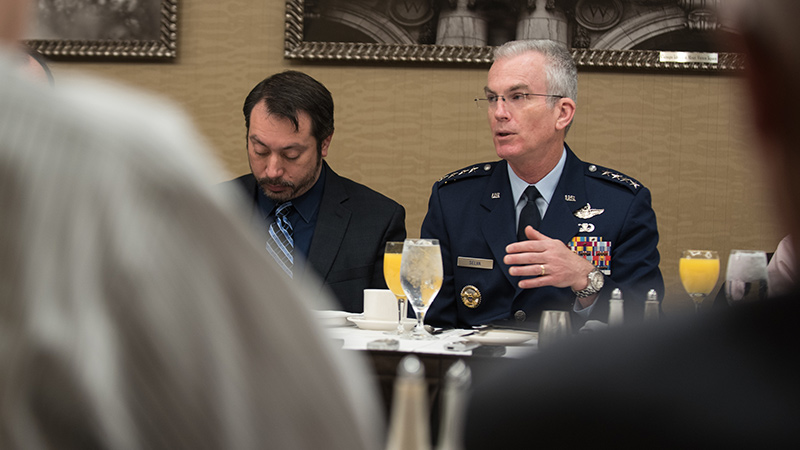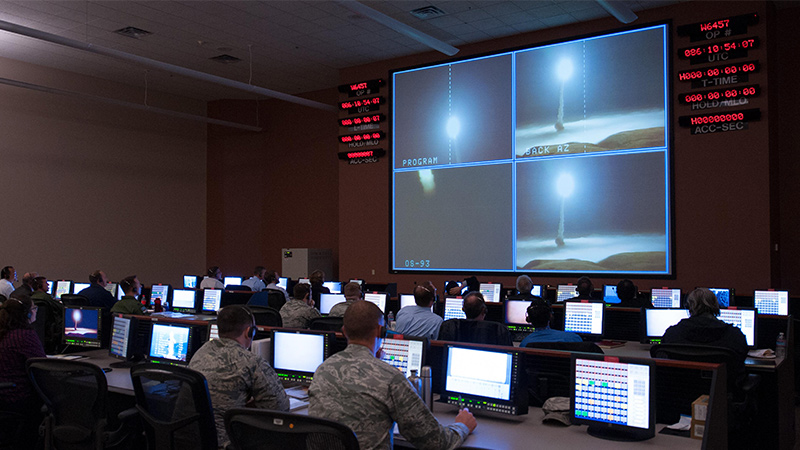U.S. General Takes Issue with Reports of Pending Shift in Nuclear Posture
By Tom Risen|February 1, 2018
As Trump calls for rebuilding U.S. arsenal, general says U.S. nuclear strategy coming on Friday is not a dramatic change
Update: The Pentagon on Friday released the final version of the Nuclear Posture Review, available online.
The story below was published Thursday.
The Pentagon’s number two general has a word to describe press reports that its forthcoming Nuclear Posture Review will lower the country’s threshold for detonating nuclear weapons and suggest development of a new kind of nuclear weapon, one that the U.S. might be less hesitant to use on an enemy.
“Inaccurate,” said U.S. Air Force Gen. Paul Selva, the vice chairman of the U.S. Joint Chiefs of Staff, in a Defense Writers Group meeting with reporters Jan. 30.
The press reports began swirling on Jan. 11 when the HuffPost obtained and posted a document that appears to be a “pre-decisional” version of the posture review. The document says the U.S. will pursue “modest supplements” to its nuclear forces and implies this could include additional “low-yield” nuclear weapons. The report suggests that supplementing low-yield weapons would empower the U.S. to deter aggression in a wider range of crises, because the warheads would not be perceived as too destructive to launch in a small-scale conflict. By supplementing its low-yield weapons, the U.S. would disabuse Russia or other adversaries that they have a “coercive advantage” with their greater number low-yield weapons, the report says.
Selva noted that low-yield warheads are already part of the U.S. inventory, and he said the document does not propose a “sea change” from U.S. strategy.
Low-yield weapons produce smaller explosions than strategic weapons and are also called tactical weapons. These can be fired from aircraft, including F/A-18s, B-2 and B-52 bombers. The Federation of American Scientists estimated in 2017 that the U.S. has 500 deployed and nondeployed tactical warheads.
President Donald Trump’s language about America’s nuclear arsenal has signaled a desire to depart from the Obama administration’s reduction of the U.S. stockpile that began during previous presidencies. In his State of the Union speech to Congress, Trump said “we must modernize and rebuild our nuclear arsenal, hopefully never having to use it, but making it so strong and so powerful that it will deter any acts of aggression.”
“Perhaps someday in the future, there will be a magical moment when the countries of the world will get together to eliminate their nuclear weapons,” Trump said. “Unfortunately, we are not there yet.”
The leaked document also states that the U.S. “reserves the right to use nuclear weapons when our national interests, our population or infrastructure are attacked with significant consequence.” That language, Selva said, should not be misinterpreted as lowering the threshold for when the U.S. will retaliate to an attack with nuclear weapons, and called the upcoming report consistent with U.S. policy on reserving the right for pre-emptive strikes.
“Context matters” he said. An attack warranting a nuclear strike would have to cause a high death toll or damage America’s nuclear command and control, he explained.
“We don’t do pre-emption as a matter of course,” Selva said. A first strike to destroy nuclear missiles before they launch remains an option once North Korea or another nation shows “hostile intent.”
Selva noted that while the U.S. since 2010 has focused on modernizing its existing nuclear infrastructure, including the Minuteman 3 ballistic missiles, potential adversaries China and Russia have built new types of missiles and warheads.
“Even with our modernization efforts we only make modest improvements,” he said. “The capability of the Russian and Chinese nuclear arsenals is actually getting better against ours, which is remaining relatively static.”
China and Russia have also become increasingly competitive against the U.S. in their research of hypersonic flight and weapons, which Selva said are also being researched by DARPA and the U.S. Navy.
“We have lost our technical advantage in hypersonics,” he said. “We haven’t lost the hypersonics fight.”






